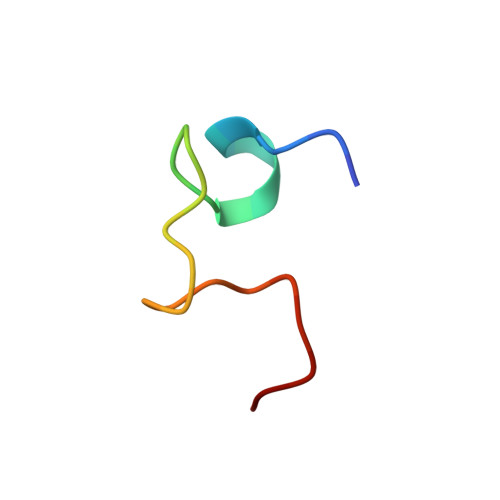Protein and metal cluster structure of the wheat metallothionein domain gamma-E(c)-1: the second part of the puzzle.
Loebus, J., Peroza, E.A., Bluthgen, N., Fox, T., Meyer-Klaucke, W., Zerbe, O., Freisinger, E.(2011) J Biol Inorg Chem 16: 683-694
- PubMed: 21437709
- DOI: https://doi.org/10.1007/s00775-011-0770-2
- Primary Citation of Related Structures:
2L61, 2L62 - PubMed Abstract:
Metallothioneins (MTs) are small cysteine-rich proteins coordinating various transition metal ions, including Zn(II), Cd(II), and Cu(I). MTs are ubiquitously present in all phyla, indicating a successful molecular concept for metal ion binding in all organisms. The plant MT E(c)-1 from Triticum aestivum, common bread wheat, is a Zn(II)-binding protein that comprises two domains and binds up to six metal ions. The structure of the C-terminal four metal ion binding β(E) domain was recently described. Here we present the structure of the N-terminal second domain, γ-E(c)-1, determined by NMR spectroscopy. The γ-E(c)-1 domain enfolds an M (2) (II) Cys(6) cluster and was characterized as part of the full-length Zn(6)E(c)-1 protein as well as in the form of the separately expressed domain, both in the Zn(II)-containing isoform and the Cd(II)-containing isoform. Extended X-ray absorption fine structure analysis of Zn(2)γ-E(c)-1 clearly shows the presence of a ZnS(4) coordination sphere with average Zn-S distances of 2.33 Å. (113)Cd NMR experiments were used to identify the M(II)-Cys connectivity pattern, and revealed two putative metal cluster conformations. In addition, the general metal ion coordination abilities of γ-E(c)-1 were probed with Cd(II) binding experiments as well as by pH titrations of the Zn(II) and Cd(II) forms, the latter suggesting an interaction of the γ domain and the β(E) domain within the full-length protein.
Organizational Affiliation:
Institute of Inorganic Chemistry, University of Zurich, Switzerland.















